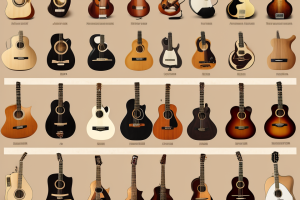
Unleash the full potential of your Xcode project with custom instruments! In this guide, we’ll walk you through the process of creating custom instruments in Xcode, giving you the tools you need to monitor and optimize your app’s performance like a pro. From setting up the basics to creating advanced customizations, we’ve got you covered. Get ready to take your app to the next level with this step-by-step guide to creating custom instruments in Xcode.
Understanding Xcode Instruments
What are Instruments in Xcode?
Xcode Instruments is a powerful performance analysis tool that is integrated into the Xcode development environment. It allows developers to analyze and optimize the performance of their applications by providing detailed information about the system’s resources, such as CPU usage, memory allocation, and battery life. Instruments can be used to measure the performance of applications during runtime, and it provides a variety of pre-built templates for common tasks, such as measuring application launch time, analyzing memory usage, and profiling CPU usage. Additionally, Instruments allows developers to create custom templates to analyze specific aspects of their application’s performance, making it a versatile tool for improving the overall performance of iOS and macOS applications.
Why Use Custom Instruments?
Custom instruments are essential for monitoring and analyzing the performance of your applications in Xcode. By creating custom instruments, you can gain a deeper understanding of your app’s performance, diagnose issues, and optimize its overall performance.
Some reasons why you should use custom instruments include:
- Monitoring Performance Metrics: Custom instruments allow you to monitor specific performance metrics that are important to your application. For example, if your app relies heavily on network operations, you can create an instrument to monitor network latency and throughput.
- Debugging Issues: Custom instruments can help you identify and diagnose performance issues in your application. By monitoring the performance of specific components or functions, you can pinpoint where the performance bottlenecks are and optimize them accordingly.
- Optimizing Performance: Custom instruments can help you optimize the performance of your application by identifying areas where it can be improved. For example, you can use custom instruments to monitor CPU usage, memory usage, and other performance metrics to identify areas where your application can be optimized.
Overall, custom instruments are a powerful tool for monitoring and optimizing the performance of your application in Xcode. By using custom instruments, you can gain a deeper understanding of your app’s performance and make informed decisions about how to optimize it.
Benefits of Custom Instruments
Custom instruments in Xcode provide numerous benefits to developers when it comes to building and testing applications. Here are some of the key advantages of creating custom instruments:
- Improved debugging: Custom instruments allow developers to track specific performance metrics and debug issues more effectively. By creating custom instruments that target specific areas of code, developers can quickly identify performance bottlenecks and optimize their applications.
- Enhanced analysis: Custom instruments provide detailed insights into the behavior of an application, allowing developers to analyze memory usage, CPU utilization, and other performance metrics. This information can be used to identify potential areas for optimization and improve the overall performance of the application.
- Faster development cycles: Custom instruments can help developers streamline their development process by providing quick feedback on the performance of their applications. This allows developers to iterate faster and more efficiently, leading to shorter development cycles and faster time-to-market.
- Better collaboration: Custom instruments can be shared among team members, allowing for better collaboration and communication around performance issues. By sharing custom instruments, team members can work together more effectively to identify and resolve performance bottlenecks.
Overall, custom instruments in Xcode provide developers with a powerful tool for analyzing and optimizing the performance of their applications. By leveraging the benefits of custom instruments, developers can build high-quality applications that meet the needs of their users.
Setting Up Custom Instruments
Identifying Performance Metrics
In order to create custom instruments in Xcode, it is crucial to first identify the performance metrics that are relevant to your application. These metrics serve as the foundation for the custom instruments that you will create, providing you with a comprehensive view of your application’s performance.
To identify performance metrics, consider the following steps:
- Define Your Goals: Start by defining the goals you hope to achieve through creating custom instruments. What aspects of your application’s performance do you want to measure and analyze? Are you looking to optimize memory usage, improve battery life, or reduce latency? Defining your goals will help you focus on the metrics that matter most.
- Select Relevant Metrics: Once you have defined your goals, select the relevant performance metrics that will help you achieve them. For example, if you are aiming to optimize memory usage, metrics such as memory allocation, deallocation, and retainability are essential. Similarly, if you are concerned about battery life, metrics like CPU usage, energy impact, and background task execution can provide valuable insights.
- Consider the Application Lifecycle: It is important to consider the different stages of your application’s lifecycle when identifying performance metrics. This includes metrics that are relevant during startup, when your application is running in the foreground, and when it is in the background or being terminated.
- Think Holistically: Remember that performance is not isolated to a single aspect of your application. Consider the interactions between various components, such as the user interface, core functionality, and external services. These interactions can have a significant impact on overall performance, and should be considered when identifying relevant metrics.
- Consult Documentation and Resources: To ensure you are identifying the most relevant performance metrics for your application, consult the documentation and resources provided by Apple. These resources can offer valuable guidance on the metrics that are most important for specific types of applications or development scenarios.
By following these steps, you will be well-equipped to identify the performance metrics that are most relevant to your application, setting the stage for the creation of custom instruments that provide a comprehensive view of your application’s performance.
Defining Custom Metrics
Defining custom metrics is a crucial step in creating custom instruments in Xcode. Custom metrics allow you to measure and track specific performance characteristics that are unique to your app or project. In this section, we will discuss the steps involved in defining custom metrics.
- Identify the Metrics You Want to Track
The first step in defining custom metrics is to identify the performance characteristics that you want to track. This could include metrics such as CPU usage, memory usage, network latency, or any other metrics that are relevant to your app or project. - Choose a Name for Your Metric
Once you have identified the metrics you want to track, you need to choose a name for your metric. The name should be descriptive and meaningful, and it should reflect the purpose of the metric. It is also important to choose a name that is not already in use by other metrics. - Define the Formula for Your Metric
After choosing a name for your metric, you need to define the formula for your metric. The formula should be written in Xcode’s performance expression language, which is a simple language that allows you to express complex performance metrics. The formula should be designed to calculate the value of the metric based on the data collected by Xcode. - Add the Metric to Your Instrument
Once you have defined the formula for your metric, you need to add it to your instrument. To do this, select the “Add Metric” option from the instrument editor’s toolbar, and enter the name and formula for your metric. You can also configure the options for your metric, such as the units of measurement and the aggregation method. - Run Your Instrument
After adding your custom metric to your instrument, you can run your instrument to collect performance data. The data collected by your instrument will include the values of your custom metrics, which you can then use to analyze and optimize the performance of your app or project.
In summary, defining custom metrics is an essential step in creating custom instruments in Xcode. By identifying the metrics you want to track, choosing a name and formula for your metric, and adding it to your instrument, you can create a powerful tool for analyzing and optimizing the performance of your app or project.
Configuring Instrument Tracking
In order to create custom instruments in Xcode, the first step is to configure instrument tracking. This involves setting up the tracking options for the instruments you want to create, including selecting the data to be tracked and configuring the tracking settings.
To configure instrument tracking, follow these steps:
- Open your project in Xcode and select the project settings.
- In the project settings, select the “Instruments” tab.
- Click on the “+” button to add a new instrument.
- Select the type of instrument you want to create.
- Configure the tracking options for the instrument. This includes selecting the data to be tracked, such as CPU usage or memory usage, and configuring the tracking settings, such as the sample rate and buffer size.
- Save the instrument settings.
Once you have configured the instrument tracking, you can begin creating custom instruments in Xcode.
Creating Custom Instrument Panels
Adding Widgets to Panels
To add widgets to custom instrument panels in Xcode, follow these steps:
- In the main interface of Xcode, select the file for the instrument panel you wish to modify.
- Click on the “View” menu at the top of the screen and select “Utilities Window.” This will open a new window with various tools and options for the selected file.
- In the Utilities window, click on the “Add Widget” button. This will bring up a menu of available widgets to add to the panel.
- Select the widget you wish to add from the menu. The widget will then be added to the panel in the desired location.
- To adjust the position or size of the widget, simply click and drag on the widget itself. You can also resize the widget by using the corner handles.
- To add additional widgets to the panel, simply repeat the process of clicking on the “Add Widget” button and selecting the desired widget.
- Once you have finished adding widgets to the panel, you can save the changes by clicking on the “File” menu at the top of the screen and selecting “Save.” The custom instrument panel with the added widgets will now be saved in the project.
Customizing Widget Layouts
Customizing the layout of widgets on an instrument panel is an important aspect of creating a custom instrument in Xcode. The layout of widgets can greatly impact the readability and usability of the instrument panel, and therefore it is important to consider the placement and arrangement of widgets carefully.
There are several ways to customize the layout of widgets on an instrument panel. One approach is to use the built-in layout options provided by Xcode. These options include horizontal and vertical arrangements, as well as grid and stacked layouts. By using these options, you can create a variety of different layouts for your instrument panel.
Another approach to customizing the layout of widgets is to use the built-in drag and drop functionality provided by Xcode. This allows you to easily move and arrange widgets on the instrument panel by simply clicking and dragging them to the desired location. You can also resize widgets by dragging the edges of the widget frame.
In addition to these built-in options, you can also customize the layout of widgets by using custom code. This can be useful if you need to create a specific layout that is not supported by the built-in options. By using custom code, you can define the placement and arrangement of widgets precisely, and create complex layouts that would not be possible with the built-in options.
Overall, customizing the layout of widgets on an instrument panel is an important step in creating a custom instrument in Xcode. By carefully considering the placement and arrangement of widgets, you can create an instrument panel that is both readable and usable, and that meets the needs of your application.
Configuring Widget Behavior
Configuring widget behavior is a crucial step in creating custom instruments in Xcode. It involves defining how the widgets on the instrument panel will behave when the user interacts with them.
There are several widget behaviors to choose from, including:
- Default behavior: This is the default behavior for most widgets, which displays the value of the widget when the user clicks on it.
- Toggle behavior: This behavior toggles the value of the widget when the user clicks on it. For example, a switch widget might toggle between “on” and “off” states.
- Slider behavior: This behavior allows the user to adjust the value of the widget by sliding a thumb up or down. This is useful for widgets that allow the user to adjust values, such as volume or brightness.
- Stepper behavior: This behavior allows the user to adjust the value of the widget by clicking on a button and entering a new value. This is useful for widgets that allow the user to enter precise values, such as a progress bar.
To configure widget behavior, you need to define the behavior in the instrument class that you are creating. This involves setting the kind property of the widget to the desired behavior, and defining any additional properties or methods that are required for the behavior.
For example, to create a toggle widget, you would define the kind property of the widget to NSOnOffControl and set the action property to a block that toggles the value of the widget when the user clicks on it.
// Define a toggle widget
[self.panel addWidget:[NSOnOffControl controlWithKey:@"myToggleWidget"]];
// Set the action block for the toggle widget
[self.panel.subviews[0].subviews[0].subviews[0].actions addAction:[self toggleAction] forTarget:self];
// Define the toggle action block
- (IBAction)toggleAction:(id)sender {
// Toggle <strong>the value of the widget</strong>
myToggleWidget.intValue = !myToggleWidget.intValue;
}
In this example, the toggleAction block is called when the user clicks on the toggle widget. It toggles the value of the widget by setting the intValue property of the widget to its opposite value.
Once you have defined the behavior of your widgets, you can add them to your instrument panel using the addWidget: method of the panel object. This method takes an instance of a widget class as its argument, and adds the widget to the panel at the specified position.
By configuring the behavior of your widgets, you can create custom instruments in Xcode that are tailored to your specific needs. Whether you need to display values, adjust settings, or perform other actions, configuring widget behavior is a key step in creating custom instruments that are both functional and user-friendly.
Debugging Custom Instruments
Running Custom Instruments
Custom instruments in Xcode are a powerful tool for monitoring and analyzing the performance of your iOS app. Once you have created a custom instrument, you can run it to see the data it collects. Here’s how:
- Open your Xcode project.
- In the Xcode toolbar, click on the “Debug” button to open the debugger.
- Click on the “Instruments” tab in the debugger.
- In the “Instruments” window, select the custom instrument you want to run from the list on the left.
- Click on the “Record” button to start recording data.
- Perform the actions in your app that you want to monitor. For example, if you created a custom instrument to monitor CPU usage, open your app and perform tasks that will cause the CPU usage to increase.
- Once you have finished performing the actions, click on the “Stop” button in the “Instruments” window to stop recording data.
- The data collected by the custom instrument will be displayed in the “Instruments” window. You can use the various graphs and tables to analyze the data and see how your app is performing.
By running custom instruments in Xcode, you can gain valuable insights into the performance of your iOS app and identify areas for improvement.
Analyzing Debugging Results
Once you have successfully instrumented your app using Xcode’s built-in tools, you may want to debug your custom instruments to identify any issues or bugs. This can be done by following these steps:
- Open the custom instrument file (.json) in a text editor.
- Locate the problematic section of code within the instrument file.
- Modify the code to address the issue.
- Save the modified instrument file.
- Launch your app in Xcode and select the custom instrument from the list of available instruments.
- Run your app and monitor the results in the Debug area of Xcode.
- If the issue persists, repeat steps 1-6 until the issue is resolved.
It is important to note that when debugging custom instruments, it is important to carefully analyze the debugging results to ensure that the issue has been properly addressed. This may involve comparing the results of the modified instrument to the original instrument to ensure that the changes made have not introduced any new issues. Additionally, it may be helpful to consult the documentation for the custom instrument framework to ensure that you are using the correct syntax and conventions when creating your custom instruments.
Resolving Performance Issues
When developing custom instruments in Xcode, it is essential to monitor and analyze their performance to ensure they function as intended. Here are some steps to help you resolve performance issues with your custom instruments:
Identify Performance Bottlenecks
To resolve performance issues, you must first identify the bottlenecks affecting your custom instrument. You can use Xcode’s built-in profiling tools, such as the time profiler and the performance recorder, to track the execution of your code and identify the specific functions or methods that consume the most time.
Once you have identified the performance bottlenecks, you can focus your efforts on optimizing those specific areas of your code to improve the overall performance of your custom instrument.
Optimize Code Execution
Optimizing code execution is crucial for improving the performance of your custom instrument. Here are some tips to help you optimize your code:
- Use efficient algorithms: Choose algorithms that are optimized for your specific use case to minimize the time it takes to process data.
- Minimize memory usage: Ensure that your code does not consume excessive amounts of memory, as this can slow down the execution of your custom instrument.
- Use multithreading: If your custom instrument requires processing large amounts of data, consider using multithreading to parallelize the processing and improve performance.
Optimize Instrument Layout and Design
In addition to optimizing your code, you should also consider optimizing the layout and design of your custom instrument. Here are some tips to help you optimize your instrument’s layout and design:
- Use efficient layouts: Choose layouts that are optimized for your specific use case to minimize the time it takes to display data.
- Minimize UI elements: Avoid cluttering your custom instrument with unnecessary UI elements, as this can slow down the performance of your instrument.
- Use efficient graphics: If your custom instrument requires displaying graphics, choose graphics that are optimized for your specific use case to minimize the time it takes to render them.
By following these steps, you can identify and resolve performance issues with your custom instruments in Xcode, ensuring they function as intended and provide accurate measurements and insights.
Optimizing Custom Instruments
Performance Tuning Techniques
To ensure that custom instruments provide accurate and reliable data, it is crucial to optimize their performance. Here are some performance tuning techniques that can help:
Reducing Instrument Overhead
Reducing the overhead of custom instruments can improve their performance. This can be achieved by minimizing the number of instrument functions, reducing the number of instrumented code paths, and minimizing the number of times the instrument function is called. Additionally, it is important to minimize the amount of data collected by the instrument, as this can also reduce overhead.
Prioritizing Data Collection
When collecting data, it is important to prioritize the data that is most critical to the performance of the application. This can help reduce the amount of data collected, which can improve performance. It is also important to ensure that the data collected is relevant and useful for analyzing performance issues.
Using Instrument Functions Efficiently
Instrument functions should be used efficiently to minimize performance overhead. This can be achieved by using instrument functions that are designed for specific purposes, such as measuring memory usage or CPU usage. Additionally, it is important to avoid using instrument functions that are not necessary for the specific performance analysis being conducted.
Profiling the Instrument
Profiling the instrument can help identify performance bottlenecks and areas for optimization. This can be achieved by using tools such as the Xcode Profiler or the Instruments app. By analyzing the profiling data, developers can identify areas of the instrument that are consuming the most resources and optimize them accordingly.
Overall, optimizing custom instruments is an important step in ensuring that they provide accurate and reliable performance data. By reducing instrument overhead, prioritizing data collection, using instrument functions efficiently, and profiling the instrument, developers can improve the performance of their custom instruments and gain valuable insights into the performance of their applications.
Improving Custom Instrument Accuracy
When creating custom instruments in Xcode, it is important to ensure that they are accurate in order to provide meaningful data. Here are some tips for improving the accuracy of custom instruments:
- Calibrate the instrument: Before using a custom instrument, it is important to calibrate it to ensure that it is providing accurate data. This can be done by running the instrument on a known set of data and adjusting the settings as needed.
- Use appropriate metrics: When creating custom instruments, it is important to use appropriate metrics that are relevant to the specific use case. For example, if measuring memory usage, it is important to use metrics that are specific to memory usage, such as heap allocation and deallocation.
- Consider the context: The context in which the custom instrument is being used can also impact its accuracy. For example, if the instrument is being used in a multi-threaded environment, it is important to take into account the impact of concurrent access to shared resources.
- Verify the results: After creating a custom instrument, it is important to verify the results by comparing them to other known metrics or by manually testing the code. This can help to ensure that the custom instrument is providing accurate data.
By following these tips, you can improve the accuracy of your custom instruments and ensure that they are providing meaningful data for your use case.
Best Practices for Custom Instrument Creation
Creating custom instruments in Xcode requires careful planning and attention to detail. To ensure that your custom instruments are optimized for performance and usability, follow these best practices:
Use Standard Templates
Apple provides several standard templates for custom instruments that you can use as a starting point. These templates are designed to be efficient and well-organized, and they can save you a lot of time and effort. When creating a new custom instrument, consider using one of these templates as a basis for your design.
Simplify the User Interface
One of the most important considerations when creating custom instruments is the user interface. The user interface should be intuitive and easy to use, but it should also be simple and uncluttered. Avoid adding unnecessary controls or features, and focus on the essential elements of the instrument. A clean and simple user interface will make your custom instrument easier to use and more efficient.
Use Custom Controls
Custom controls are an important part of custom instruments. Custom controls allow you to create unique and customized interfaces that are tailored to your specific needs. When creating custom controls, consider the following tips:
- Use standard controls whenever possible. Standard controls are already optimized for performance and usability, and they are easy to use.
- Keep custom controls simple and intuitive. Custom controls should be easy to understand and use, and they should be designed to support the specific needs of your custom instrument.
- Test your custom controls thoroughly. Test your custom controls in a variety of scenarios to ensure that they are reliable and effective.
Use Cocoa Bindings
Cocoa bindings are a powerful tool for creating custom instruments. Cocoa bindings allow you to create dynamic and responsive interfaces that update automatically in response to changes in your data. When using Cocoa bindings, consider the following tips:
- Use Cocoa bindings to simplify your code. Cocoa bindings can reduce the amount of code you need to write, and they can make your custom instrument easier to use and maintain.
- Use Cocoa bindings to create dynamic and responsive interfaces. Cocoa bindings can update your user interface in real-time, providing a more dynamic and engaging experience for your users.
- Test your Cocoa bindings thoroughly. Test your Cocoa bindings in a variety of scenarios to ensure that they are reliable and effective.
By following these best practices, you can create custom instruments that are optimized for performance and usability. Use standard templates, simplify the user interface, use custom controls, and use Cocoa bindings to create custom instruments that are both effective and easy to use.
Integrating Custom Instruments into Xcode Workflows
When it comes to optimizing custom instruments in Xcode, one key aspect is integrating them into the overall workflow of the development process. This involves creating custom plugins that can be used in Xcode’s build and test processes, allowing developers to easily incorporate the custom instruments into their builds and tests.
Here are some steps to follow when integrating custom instruments into Xcode workflows:
- Create a new Xcode project specifically for the custom instruments. This will help keep the custom instruments separate from other projects and make it easier to manage them.
- In the new project, create a new target for the custom instruments. This will allow the custom instruments to be built and tested separately from the main app target.
- Add the custom instruments to the new target by dragging and dropping them into the “Frameworks, Libraries, and Embedded Content” section of the project settings.
- Add the custom instruments to the app target by dragging and dropping them into the “Embedded Binaries” section of the project settings.
- In the app target’s build phases, add the custom instruments as a copy file stage. This will ensure that the custom instruments are copied into the app bundle during the build process.
- In the app target’s test cases, add the custom instruments as a dependency. This will ensure that the custom instruments are loaded and used during the test process.
By following these steps, developers can easily integrate custom instruments into their Xcode workflows, making it easier to incorporate them into their builds and tests.
FAQs
1. What are instruments in Xcode?
Instruments are built-in tools in Xcode that allow developers to analyze and optimize the performance of their applications. They provide a variety of features, such as performance profiling, memory usage analysis, and CPU sampling, to help identify and fix performance issues.
2. How do I create a custom instrument in Xcode?
To create a custom instrument in Xcode, follow these steps:
1. Open your project in Xcode.
2. In the Xcode menu, go to “Product” and select “Instrumentation” and then “Add New Instrument…”.
3. Choose the type of instrument you want to create (e.g. profiler, trace, or debugger) and give it a name.
4. Customize the settings and options for your instrument as needed.
5. Click “Finish” to create the instrument.
3. How do I use instruments to analyze my application’s performance?
To use instruments to analyze your application’s performance, follow these steps:
1. Launch your application in Xcode.
2. In the Xcode menu, go to “Product” and select “Instrumentation” and then the name of the instrument you created.
3. Select the process for your application and click “Start” to begin analyzing its performance.
4. Use the various features and controls in the instrument to analyze and optimize your application’s performance.
5. When you are finished, click “Stop” to stop the instrument and view the results.
4. How do I interpret the data collected by instruments?
To interpret the data collected by instruments, you can use the various charts, graphs, and tables provided by the instrument. Each instrument provides different types of data, such as CPU usage, memory usage, and performance metrics, that can help you identify performance issues in your application. You can also use the instrument’s settings and options to customize the data that is collected and displayed.







